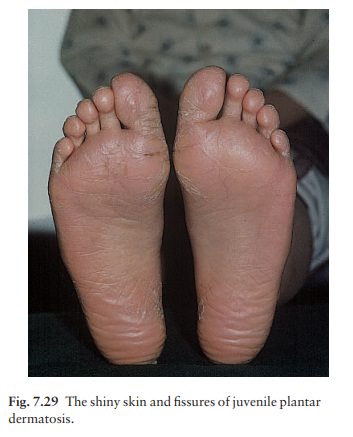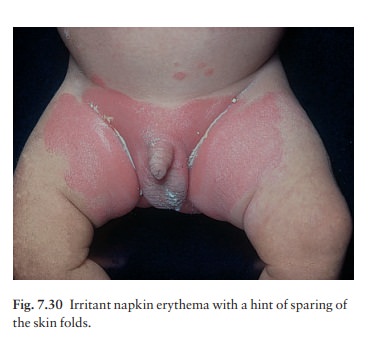Chapter: Clinical Dermatology: Eczema and dermatitis
Juvenile plantar dermatosis

Juvenile
plantar dermatosis (Fig.
7.29)
Cause
This condition is thought to be related to the imper-meability of modern socks and shoe linings with subsequent sweat gland blockage, and so has been called the ‘toxic sock syndrome’! Some feel the condi-tion is a manifestation of atopy.

Presentation and course
The
skin of the weight-bearing areas of the feet, particularly the forefeet and
undersides of the toes, becomes dry and shiny with deep painful fissures that
make walking difficult. The toe webs are spared. Onset can be at any time after
shoes are first worn, and even if untreated the condition clears in the early
teens.
Investigations
Much
time has been wasted in patch testing and scraping for fungus.
Treatment
The
child should use a commercially available cork insole in all shoes, and stick
to cotton or wool socks. An emollient such as emulsifying ointment or 1%
ichthammol paste, or an emollient containing lactic acid, is as good as a
topical steroid.
Cause
The
most common type of napkin eruption is irritant in origin, and is aggravated by
the use of waterproof plastic pants. The mixture of faecal enzymes and ammonia
produced by urea-splitting bacteria, if allowed to remain in prolonged contact
with the skin, leads to a severe reaction. The overgrowth of yeasts is another
aggravating factor. The introduction of modern disposable napkins has, over the
last few years, helped to reduce the number of cases sent to our clinics.
Presentation
The
moist, often glazed and sore erythema affects the napkin area generally (Fig.
7.30), with the exception of the skin folds, which tend to be spared.

Complications
Superinfection
with Candida
albicans is common, and this may lead to small erythematous papules
or vesicopustules appearing around the periphery of the main eruption.
Differential diagnosis
The
sparing of the folds helps to separate this condition from infantile
seborrhoeic eczema and candidiasis.
Treatment
It
is never easy to keep this area clean and dry, but this is the basis of all
treatment. Theoretically, the child should be allowed to be free of napkins as
much as possible but this may lead to a messy nightmare. On both sides of the
Atlantic disposable nappies (diapers) have largely replaced washable ones. The
superab-sorbent type is best and should be changed regularly, especially in the
middle of the night. When towelling napkins are used they should be washed
thoroughly and changed frequently. The area should be cleaned at each nappy
change with aqueous cream and water. Protective ointments, e.g. zinc and castor
oil ointment, or silicone protective ointments, are often useful, as are
topical imidazole prepara-tions that stop yeast growth. Potent steroids should
be avoided but combinations of hydrocortisone with antifungals or
antiseptics are often useful.
Related Topics